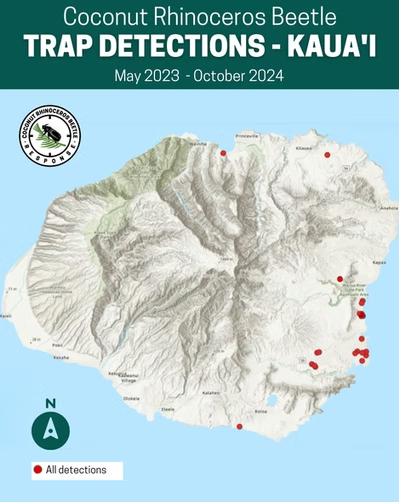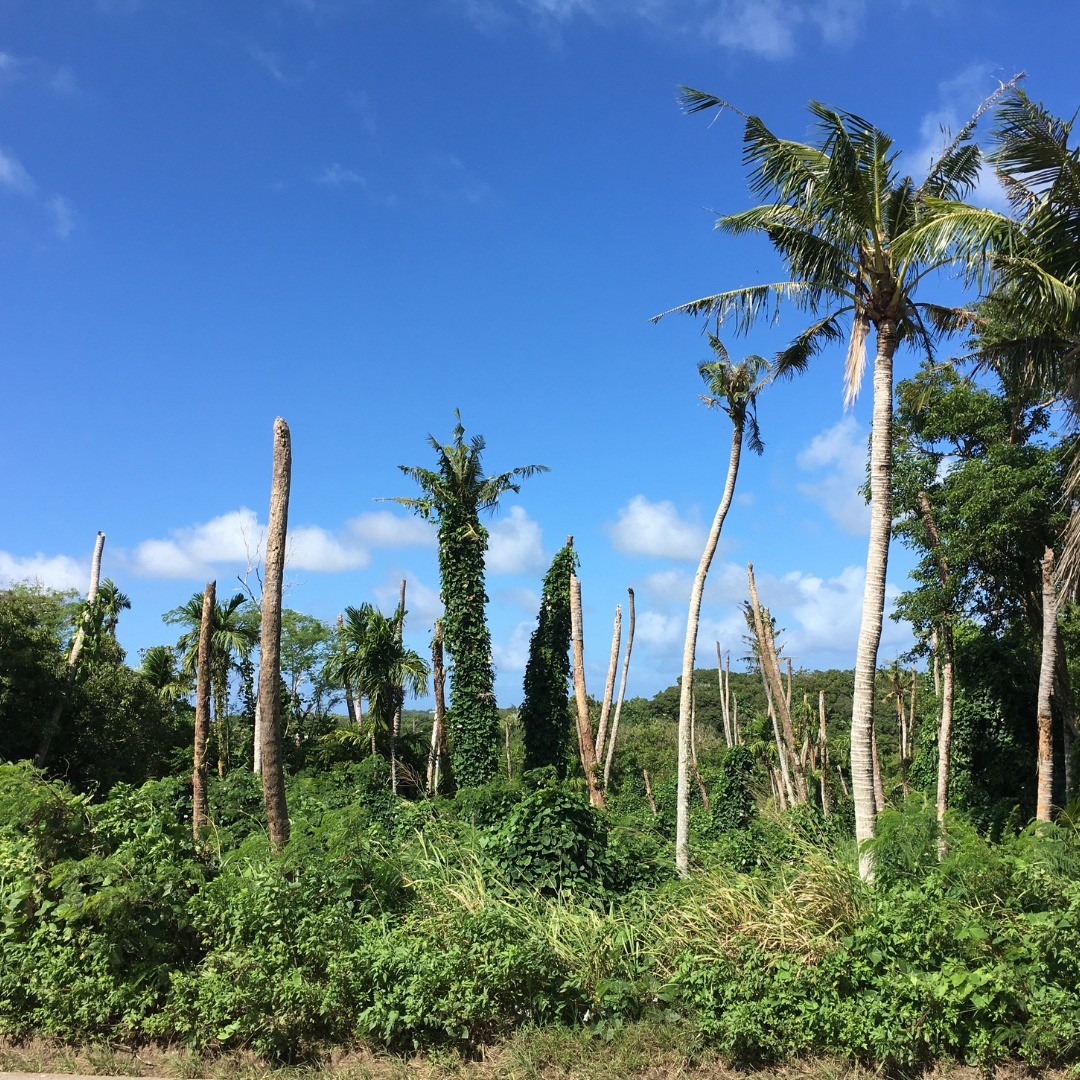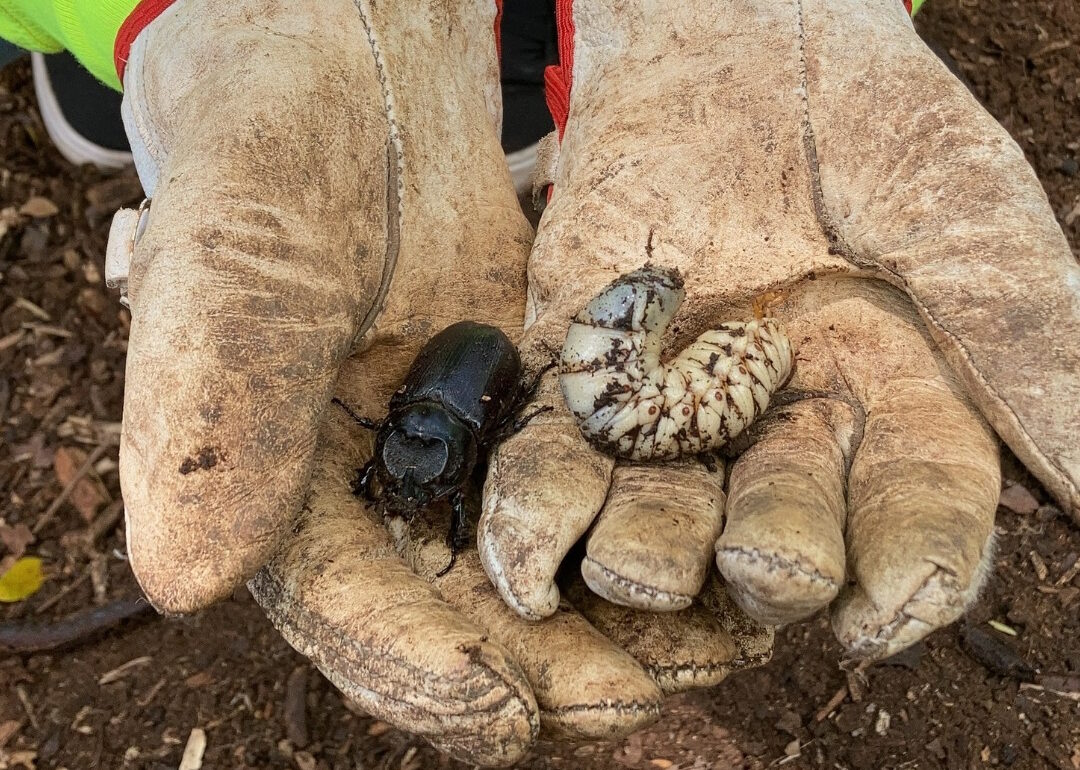Few sights define Kauai more than a towering palm tree silhouetted against a golden sunset. From the coconut-lined beaches of Wailua to the manicured resorts of Poipu, these trees are more than just scenery – they are symbols of the island’s identity, culture, and economy. But a destructive newcomer now threatens Kauai’s palms: the coconut rhinoceros beetle (CRB).
Originally native to Southeast Asia, the coconut rhinoceros beetle (Oryctes rhinoceros) has already devastated palm populations across the Pacific, from Guam to Oahu. Its recent arrival on Kauai has triggered serious alarm among farmers, landscapers, and conservationists alike. If left unchecked, this beetle could transform Kauai’s landscapes – and not for the better.
What Is the Coconut Rhinoceros Beetle?
The coconut rhinoceros beetle is a large, dark brown to black insect, measuring up to 2.5 inches in length. Its horned appearance gives it its name, but it is not the beetle’s looks that worry experts. Adult beetles bore into the crowns of palm trees to feed on sap, cutting through young fronds and inflicting damage that can kill the tree or leave it permanently disfigured.
Each female beetle can lay 50 to 140 eggs in their 4-9 months lifetime, typically in decaying vegetation, mulch piles, or even improperly managed green waste – conditions often found on tropical islands like Kauai. Larvae develop into new adults in just a few months, creating a breeding cycle that can quickly spiral out of control if not managed.
How Serious Is the Threat to Kauai?
Extremely serious. On Oahu, where CRB was first detected in 2013, entire groves of coconut and other palm species have suffered catastrophic losses. Efforts there, coordinated by the Coconut Rhinoceros Beetle Response Team, have contained but not eradicated the pest. On Guam, an infestation has led to damage of over 25% of the island’s coconut palms.
Palm trees are vital to Kauai’s environment and economy. They stabilize coastal soils, offer critical wildlife habitat, and are integral to tourism and agriculture. Coconut palms, in particular, are valued for their fruit, oil, and ornamental beauty. Losing them would be more than an aesthetic blow – it would ripple through the island’s ecology and livelihood.
How Did the Beetle Get to Kauai?
First detected on Kauai in May 2023, experts suspect the beetle likely hitchhiked in green waste, mulch, compost, or contaminated nursery shipments from other Hawaiian Islands or even from the mainland. Given the interconnected nature of freight movement between islands, the risk of accidental spread remains high.

(CRB Response Website)
In 2023-2024, trapping surveys confirmed the presence of coconut rhinoceros beetles near Lihue Airport and along the eastern shorelines, as well as spots on the North Shore and in Poipu.
What Is Being Done?
A Coconut Rhinoceros Beetle Response team has been mobilized in the Hawaiian Islands. Their efforts include:
- Surveillance: Hundreds of pheromone traps have been deployed across Kauai to monitor beetle populations.
- Tree inspections: Arborists are inspecting palms island-wide for signs of beetle damage, such as V-shaped cuts in fronds or holes in the crown.
- Public education: On Kauai, residents are urged to report any suspicious palm damage or sightings through hotlines and apps.
- Green waste management: Strict guidelines are advised for the transport, treatment, and disposal of mulch and compost materials.
Yet experts warn that without community-wide cooperation, the beetle could become entrenched, making eradication impossible and long-term control costly.
How You Can Help
Protecting Kauai’s palms will take a collective effort. Here’s what residents and visitors can do:
- Stay alert: Look for signs of damage on palm trees, especially new or deformed fronds.
- Report sightings: If you suspect a tree has been attacked, contact CRB Response immediately at (808) 679-5244 or visit the CRB Response website at www.crbhawaii.org/report.
- Be cautious with green waste: Avoid moving mulch, compost, or soil unless it has been treated and approved for transport. Support clean-up efforts. Volunteer for local campaigns to clean and monitor green spaces where beetles might breed.
- Plant wisely: Diversifying plantings can make landscapes more resilient to pests and reduce the beetle’s impact.

(Hawaii Invasive Species Council/DLNR)
What to Look For
Be alert for these warning signs on Kauai’s palm trees. Early detection can save a tree – and help protect the island.
- V-Shaped Cuts in Fronds: Look for deep, V-shaped notches or tears in newly emerging fronds. This damage is often one of the first visible symptoms.
- Holes in the Crown: Small to medium-sized boreholes may appear near the top (crown) of the tree where the beetle chews into the growing tissue.
- Deformed or Stunted New Leaves: New fronds may emerge misshapen, shredded, or stunted if the beetle has damaged the central growth area.
- Dead or Dying Crown: In severe infestations, the entire top of the tree may collapse or turn brown as the beetle destroys the tree’s growing point.
- Sawdust-Like Frass: Fine, powdery material (insect droppings and wood shavings) may accumulate around boreholes at the tree’s crown.
- Unusual Beetle Sightings: Large, dark brown beetles (up to 2.5 inches long) with a curved horn on the head, particularly near green waste piles or around lights at night.
A Race Against Time
Kauai stands at a critical crossroads. If aggressive action is taken now, it may still be possible to contain the coconut rhinoceros beetle and save the island’s beloved palms. But if the beetle is allowed to spread, the consequences could be visible for generations: beaches without their shady sentinels, gardens stripped of their tropical icons, and a piece of Kauai’s soul lost to an invasive pest.
The island’s palms have stood for centuries against hurricanes, tsunamis, and changing times. Whether they can survive this new threat depends on swift action, scientific perseverance, and the vigilance of every Kauai resident and visitor.


